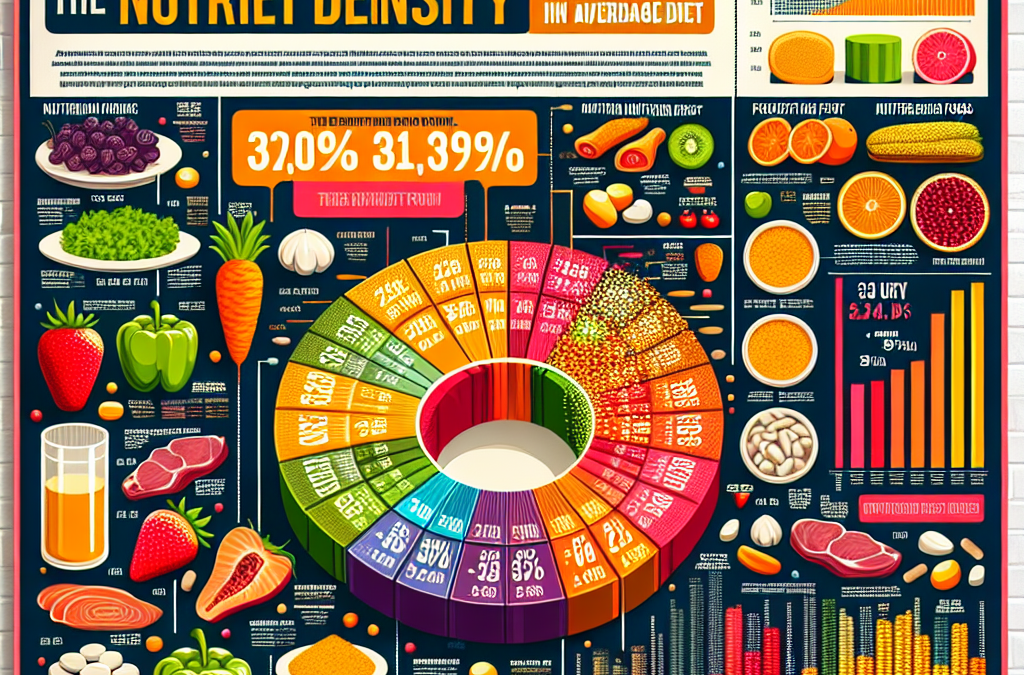The Shocking Truth About Nutrient Density in Your Diet
- Nutrient Density Explained
- The Importance of Nutrient-Dense Foods
- How to Identify Nutrient-Dense Options
- Common Misconceptions About Nutrient Density
Nutrient Density Explained
Understanding Nutrient Density
When I first stumbled upon the concept of nutrient density, it really blew my mind. Nutrient dense foods are those that provide a high amount of nutrients relative to their calorie count. Imagine eating a bowl of strawberries compared to a bowl of sugary cereal. The strawberries are overflowing with vitamins, minerals, and antioxidants while the cereal offers little more than empty calories.
The real kicker is that many people don’t realize that what they eat might be packing a caloric punch without the nutrients to back it up. This is where understanding nutrient density becomes crucial. It’s not just about cutting calories; it’s also about what those calories are made up of!
Once I got my head around this, everything changed. It’s not just about eating less; it’s about eating smarter. This concept propelled me to look deeper into my food choices, which brings me to the next key point: why nutrient-dense foods are so important.
Nutrient Density vs. Caloric Density
Caloric density is all about the number of calories in a given volume of food. Let’s say you have a slice of cake—sure, it’s a tasty treat, but the high caloric density means you’re likely consuming a whole ton of calories without much nutrition in return. On the other hand, nutrient density focuses on the bang you get for your buck in terms of vitamins and minerals.
Realizing the difference was a game-changer for me. It became clear that I could feel full and satisfied with fewer calories by focusing on nutrient-dense foods. Not to mention, I started feeling a lot better overall—less sluggish and more energized!
If you’re looking to improve your diet, getting your head around nutrient density is the first step. It gives you a roadmap of what to look for when you’re shopping at the grocery store or meal prepping for the week ahead.
Examples of Nutrient-Dense Foods
So what exactly are these nutrient-dense foods I keep yammering on about? Fresh fruits and veggies are at the top of the list. Leafy greens like kale and spinach are incredible; they’re low in calories but rich in essential vitamins. Meats such as salmon are packed with omega-3s and proteins, while legumes offer a solid plant-based protein source.
And let’s not forget about nuts and seeds—those little powerhouses of nutrition that are super versatile! When I began incorporating more of these into my diet, I truly felt a shift in my energy levels and overall well-being.
In the end, paying attention to nutrient density means prioritizing whole foods over processed ones. The more you focus on nutrient-dense foods, the more you’ll naturally find yourself steering clear of those empty-calorie culprits!
The Importance of Nutrient-Dense Foods
Health Benefits of Nutrient Density
It’s one thing to know how nutrient density impacts our food choices, but diving into the health benefits is where the real fun begins! The first benefit I noticed was improved energy. By making nutrient-dense foods a staple in my meals, I felt less tired and more alert throughout the day.
Then there’s the matter of disease prevention. Many chronic diseases are linked to poor nutrition. By incorporating a variety of nutrient-dense foods, I was not just filling my belly but also fortifying my body against illness. It’s like building a fortress from the inside out.
Lastly, there are undeniable benefits for mental health. Foods rich in omega-3s, antioxidants, and vitamins can have a profound effect on mood and cognitive function. For me, that meant feeling more focused and even a bit happier.
Nutrient Density and Weight Management
Another interesting reality I discovered is the relationship between nutrient density and weight management. When you’re eating foods high in nutrients, you can often eat in larger quantities without packing on pounds. Sure, those nutrient-dense strawberries don’t carry the same caloric load as a slice of cheesecake!
This gives you the freedom to enjoy your meals, savor flavors, and feel full without the guilt. I found that making this shift helped me maintain a healthier weight without feeling deprived. And who doesn’t love the sound of that?
Additionally, when your body is getting the nutrients it needs, cravings tend to decrease. You start instinctively reaching for the good stuff instead of those sugary snacks. This is one powerful way nutrient density can aid in weight management!
The Role of Nutrient Density in a Balanced Diet
Many folks think that a balanced diet means cutting out certain foods, but that’s a myth! Instead, I learned that the key is all about adding more nutrient-dense foods to my plate. This enhances my meals and gives me all the essential nutrients.
It’s also about variety—having a wide range of nutrient-dense foods means I’m more likely to hit all the vitamin and mineral bases. Whenever I cook, I aim for a rainbow of colors on my plate. Those vibrant veggies are not just pretty to look at; they signify a range of nutrients.
This mindset shift turned my approach to meals from rigid and restrictive to enjoyable and nourishing. Eating should be an experience, not a chore, and embracing variety is key!
How to Identify Nutrient-Dense Options
Reading Nutrition Labels
Initially, I dreaded reading nutrition labels. They often felt like a whole different language! But once I got the hang of them, they became an invaluable tool in my quest for nutrient density. The first thing I look for is the ingredient list—if you see a ton of unpronounceable words, it’s usually a sign to steer clear.
Then, I pay attention to the nutrient breakdown. A good baseline is the percentage of Daily Value (%DV) listed. Foods that offer 20% or more for essential nutrients are often considered nutrient-dense. This helped me start making better choices while grocery shopping, saving me time on meal prep.
Get an Amazing Discount on Best Organic SuperFood Product!
Lastly, I set a personal goal: to eat more whole foods. That means if it’s easy to identify in its most natural form—think fruits, veggies, and grains—it’s likely packed with nutrients.
Choosing Whole Foods Over Processed
One of my favorite lessons learned about identifying nutrient-dense options is the importance of choosing whole foods over processed ones. It’s easy to grab a box of processed snacks, but when I take a second to think about my options, it’s about finding foods that are as close to nature as possible.
Fruits and veggies are my go-tos, of course, but I’m also a huge fan of whole grains like quinoa and brown rice. They not only fill me up but also come packed with fiber and nutrients. Switching to whole grains was a small adjustment that had an impressive impact on my energy levels.
This doesn’t mean I never indulge in processed snacks, but I make sure they’re the exception, not the rule. My body feels so much better when I prioritize whole foods!
Practical Tips for Meal Prepping
I can’t stress how important it is to plan your meals ahead of time. When I started meal prepping, I made it a goal to include a balanced mix of nutrient-dense foods. This is how I managed to strike a balance in my diet and avoid falling back into the processed-food trap.
One easy tip I picked up was to batch cook and freeze meals. When veggies are roasted and grains are cooked in advance, I can throw together a balanced plate in no time. It makes healthy eating so much easier, especially on busy days!
Lastly, don’t forget about snacks! I love to keep nutrient-dense options like nuts, seeds, and hummus on hand. They fill the gaps between meals and keep me on track with my eating habits.
Common Misconceptions About Nutrient Density
Nutrient Density vs. Caloric Restriction
A misconception that I once held was that nutrient density equated to calorie deprivation. Many think that if they eat fewer calories, they’re naturally eating healthier. But that couldn’t be further from the truth! In my experience, focusing solely on calories led to feelings of deprivation, which likely drove me to binge on less nutritious choices.
Nutrient density isn’t about starving yourself; it’s about fueling your body with what it truly needs. Once I shifted my perspective, the weight fell off naturally because I was nourishing my body instead of restricting it.
Now, I focus on balancing what I enjoy with nutrient-dense foods. This kinder approach to eating has not only helped me physically but has also positively impacted my mental relationship with food.
Healthy Food Is Expensive
Another misconception that held me back was the idea that healthy, nutrient-dense foods are always expensive. I used to think I could never afford it. But let me tell you: with a little planning and creativity, I found that it’s totally doable!
Shopping at local farmers’ markets or buying seasonal produce can save some bucks. Plus, learning to cook at home instead of dining out has made a huge difference in my budget and my health.
Not to mention, figuring out how to incorporate more plant-based proteins like beans and lentils into my diet helped me stretch my groceries without sacrificing nutrition. It’s all about finding what works for you and exploring your options!
All Healthy Foods Are Nutrient-Dense
Here’s the thing: not all healthy foods are necessarily nutrient-dense. Some touted “health foods” can still be high in calories with very little nutritional value. For example, some smoothies sound healthy, but if they’re loaded with added sugars and calories, they don’t quite hit the mark.
I learned to dig deeper and examine the ingredient lists. Every food can be categorized on a spectrum! Realizing this led me to become more mindful about what I consumed—it’s not just about picking the health food aisle; it’s about making informed choices.
This also means customizing meals to ensure they are as nutrient-dense as possible. I tend to prioritize whole and minimally processed foods whenever I can!
Frequently Asked Questions
What are nutrient-dense foods?
Nutrient-dense foods are those that provide a high number of vitamins, minerals, and other nutrients relative to their calorie content. Examples include fruits, vegetables, lean proteins, whole grains, and legumes.
Why is nutrient density important?
Nutrient density is crucial because it allows us to maximize our nutrient intake while minimizing caloric intake. This can help with weight management and overall health, reducing the risk of chronic diseases.
How can I identify nutrient-dense foods when grocery shopping?
Look for whole foods with minimal processing. Checking nutrition labels can also help; aim for foods that provide a high %DV for vitamins and minerals relative to their calorie count.
Can healthy foods be unhealthy?
Absolutely! Some “healthy” foods can be deceptively high in sugars or unhealthy fats. It’s important to evaluate the ingredients and nutrition facts to ensure you’re making beneficial choices.




